Our Q3 FY23 letter to shareholders
An update to customers, stakeholders, and shareholders on our mission to unleash the potential in every team.
Fellow shareholders,
The past months have been a dynamic period in Atlassian’s history. We reorganized our company in response to the changing and difficult macroeconomic environment. We made tough calls to prioritize the most critical work and rebalanced our team so we can run faster at our top priorities, which unfortunately meant saying goodbye to roughly 500 Atlassians.
Now we’re focused on executing. As a company, we have massive growth opportunities in front of us, particularly in cloud migrations, ITSM, and serving our enterprise customers in the cloud.
Just as our agile DNA helps us respond to changes in the economic environment, our unique business model allows us to move quickly as new technologies emerge. When advances in generative AI exploded onto the scene early this year, we already had years’ worth of experience building AI-powered features. Now we can combine large language models (LLMs) with our existing machine learning models, and deliver results tailored for the customer’s context to create entirely new, hyper-customized experiences.
Our excitement around AI is grounded in the fundamental belief that no matter what technologies are trending, teamwork is always the backbone of human achievement. As we build new ways to supercharge collaboration, we see three forces shaping the way teams work together:
- Software continues to eat the world, turning every business into a digital business. And the meteoric rise of AI technologies in the workplace is giving this trend a turbo-boost.
- Many organizations prescribe narrow ways of working in an attempt to keep their teams aligned. But collaboration isn’t “one size fits all” and teams need the autonomy to adopt the tools and practices that suit them best.
- Distributed work is here to stay. Even though many companies mandate some in-office time, we believe the days of coming in every day from 9 to 5 are over. Atlassian is leading the way in this space, leaning into flexible work arrangements at scale and sharing the lessons we learn.
Atlassian’s mission is to unleash the potential of every team so they can meet whatever challenge comes their way. Our products set teams up for success – allowing them to work differently, together – so they can turn today’s dreams into tomorrow’s reality.
More and more customers on cloud nine 🌤️
Enterprise migrations have nearly doubled over the past year, with customers continuing to move to the cloud from both Data Center and Server. This is one of our highest priorities as a company and an area where we’re increasing our investment in support services and tooling so we can migrate more customers, faster. (To wit, a certain US-based home improvement giant completed their Confluence migration from Server to Cloud in under a week!)
Unlocking cloud for the enterprise 
Enterprise-focused improvements across our entire platform removed barriers to cloud for even more customers. First, we shipped support for 50,000-user Confluence instances, more granular data residency controls and 20,000-agent support (beta) in Jira Service Management, and the ability for customers to centrally manage security for their Atlassian cloud users in a more flexible way.
In concert, we launched Atlassian Analytics into general availability after working with customers like DISH Networks, PayPal, and H&M during the early access phase. It is now incorporated into the Enterprise editions of Jira Software, Jira Service Management, and Confluence.
With Atlassian Analytics, customers can bring data from their Atlassian products together with data from 3rd-party tools like GitHub, Salesforce, Workday, and Circle CI to uncover insights into how their teams work and where they’re struggling, then use those insights to make faster, more confident decisions. We also included 20+ data visualization templates that let customers create dashboards in just minutes, and the ability to embed dashboards and charts in other Atlassian products for easier sharing.
Preventing incidents before they happen 
Finally, we launched the early access program for Beacon, our new threat-detection and mitigation product. With cyberattacks becoming more frequent and sophisticated, our customers are prioritizing security in the hopes of staying out of the headlines. Thanks to the power of our platform, we can help.
Beacon gives customers a simple way to detect, investigate, and address risky or suspicious user behavior across their Atlassian cloud products. 🕵️♀️ Is someone opening loads of Jira issues in a very short time? Running suspicious-looking searches in Confluence? Changing authentication rules in Bitbucket? Beacon will alert customer admins to red flags like these so they can take action before things get out of hand.
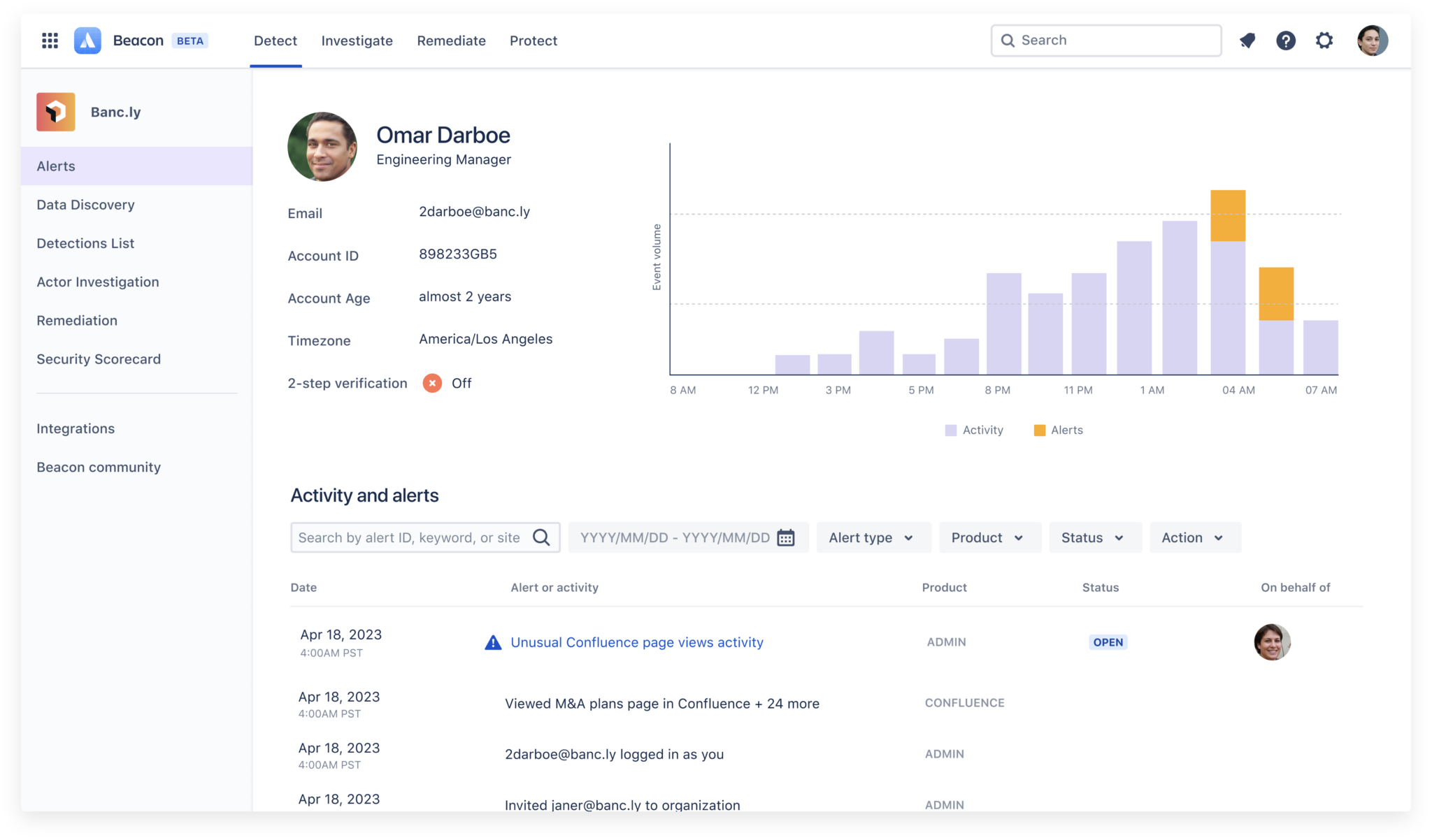
But wait! There’s more.
In addition to the product announcements above, we shipped platform enhancements and product features in Q3, demonstrating our commitment to delivering innovation and customer value.
- Easier request type configuration in Jira Service Management
- Release notes surfaced in the admin panel across multiple cloud products
- Workspace- and product-specific API tokens in Bitbucket
- API tokens for data access control at the workspace level in Bitbucket
- Enhanced automation templates and rules for Confluence
- Improved accuracy on exact-phrase searches across all Jira products
- Updated experience for creating, tracking, and reporting OKRs in Jira Align
- Visualization of the relationships between goals, OKRs, and their child objectives in Jira Align
- Faster editing for objectives tracked in Jira Align
- Support for migrating Jira Software projects from one cloud instance to another
- Data loss prevention capabilities across all cloud products
- Webhooks for delivering audit logs in real time in Confluence and Jira Software
- API access restrictions for external and managed user accounts
- Data classification abilities for admins of Confluence and all Jira products
- Option for users to include their teammates when requesting to try new Atlassian products
![]() Be the first to know what’s shipped. Subscribe to our cloud updates emails here.
Be the first to know what’s shipped. Subscribe to our cloud updates emails here.
Three global markets, one common platform for teamwork 
As a regulated financial institution managing cryptocurrency assets, trust is a requirement for Atlassian customer Finoa, not a luxury. What’s more, innovating in financial services is complex, especially in Germany, home to some of the most advanced crypto regulations.
Finoa began with collaboration tools from various vendors and an on-premises wiki. But information was often difficult to find, and few people used the wiki because it wasn’t intuitive. They wanted more automation and better alignment across their teams. As Finoa started comparing options, they learned about our Enterprise edition for cloud, and knew they’d found the right fit.
Today, every Finoa department uses Jira Software, Jira Service Management, and Confluence in their daily work. By standardizing on Atlassian, Finoa is innovating with the speed, flexibility, and visibility of a startup, along with the organization and security controls of an established financial institution.

Finoa’s story has played out inside the walls of thousands of our customers over the years. And with our three-pronged approach of addressing the work management, agile/DevOps, and ITSM markets, we aim to help thousands more reap the same benefits.
Work management 
Teams such as finance and marketing have been using Jira Software since back when it was called “JIRA,” configuring their way around the developer-oriented nature of the product. Two years ago, we introduced Jira Work Management: a friendly and intuitive way for business teams to harness the power of Jira. Today, we’re happy to say that Jira Work Management’s customer base has grown nearly 50% year-over-year, with monthly active users up more than 80% in the same time period.
As part of our Atlassian Together offering for cloud (which also encompasses Confluence, Trello, and Atlas), Jira Work Management is helping customers unlock wall-to-wall teamwork by bringing technical and non-technical teams onto a common platform while still allowing each team to choose the tools that work best for them.

Atlassian has been in the work management game since we launched Confluence in 2004. From its humble beginnings as a wiki-like workhorse powering the exchange of knowledge and ideas across an organization, Confluence has evolved into a world-class collaboration engine supporting ever more ways to create and share rich content. This quarter we built on that legacy with new content types and easier ways to work with people outside your company.
Brainstorm without borders using whiteboards
Every project starts with an idea. The best thing about Confluence is that it gets those ideas out of people’s heads and into a shareable format. Historically, Confluence has done that through text and images. Now, we’ve introduced whiteboards: a new modality for sharing ideas with as much (or as little) structure as teams care to impose.
With Confluence whiteboards, teams can sketch, type, and use digital sticky notes to jot down ideas, then turn them into deliverables. One click converts a note into a Jira issue that can be edited directly from the whiteboard. And with the ability to embed artifacts from other Atlassian tools, teams can use whiteboards to create a sharable canvas showing how all the pieces of a project connect.
Connect the dots automatically with native databases
The moment a project kicks off, it generates a flurry of interconnected data around tasks, owners, dates, deliverables, and more. Customers told us they want a structured way to connect work in Confluence without manual updates across multiple pages and we’re responding with another new content type: databases.
Databases are structured dynamic tables that help teams organize information that they can reference anywhere else in Confluence. Table entries are synced in real time so information is always up to date, regardless of where it’s surfaced.
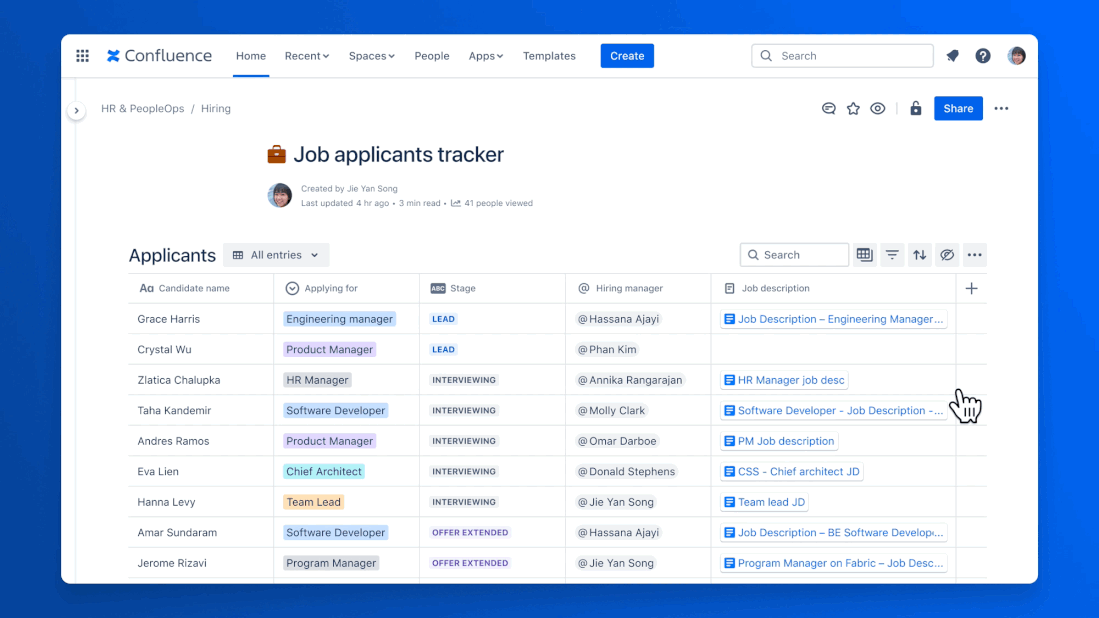
External collaboration features let teams share with anyone, anywhere
Confluence now features public links, which provide a read-only view of pages teams can share with customers and vendors without needing to manage additional user seats. And when it’s time for deeper collaboration, guest access facilitates it. Users can give up to five guests access to a single Confluence space, removing logistical barriers to collaboration at a time when organizations need to streamline wherever possible.

Agile/DevOps 
Not-so-fun fact: some studies show that three-quarters of product managers struggle to determine how valuable their product is to customers. That’s why product discovery – the process of refining ideas based on a deep understanding of user needs – is quickly becoming an essential part of the software development lifecycle. It’s also why we built Jira Product Discovery.
When product teams are in the pie-in-the-sky envisioning phase, they need to gather and organize information that is well upstream of epics and tasks. In the past, ideas and feedback have been scattered across spreadsheets, backlogs, and notebooks (or just lived in product managers’ heads). Chaos! ![]() Now, Jira Product Discovery offers a dedicated space for PMs to collaborate with each other, and just as importantly, with their development teams.
Now, Jira Product Discovery offers a dedicated space for PMs to collaborate with each other, and just as importantly, with their development teams.
Product managers can proceed with more confidence by gathering context and insights that help them prioritize what will make the biggest difference for their customers. From there, custom roadmaps keep both the team and their stakeholders abreast of the what, when, and why. And because it’s part of the Jira family, it only takes a few clicks to turn the best ideas into issues for the development team to work on.

Tested (and adored) by customers like Canva and Cisco while in beta, Jira Product Discovery will be generally available in the coming months.
IT service management 
An under-recognized affliction has been plaguing enterprises for years. We call it “Bad Service Management” (or, BSM). BSM flares up when development, operations, and business teams work in silos, making it impossible to deliver great service experiences. Tell-tale symptoms include bloated budgets, irritable teammates, dizziness from complex setups, nausea from clunky outdated interfaces, and blurred vision. ![]()
Fortunately, there’s a reliable cure for BSM: replacing legacy ITSM systems with Jira Service Management.
At our ITSM-focused event in December, we kicked off our crusade to end BSM. While we’ve had a lot of fun with this lighthearted make-the-switch campaign, we’re dead serious about stealing the competition’s thunder. As demonstrated by customers like The Very Group and Zocdoc, we’re winning over organizations of all shapes and sizes.

Meanwhile, our product team has been nose to the grindstone building always-on virtual agents that deliver basic service to employees while human IT staff focus on more complex requests. With the help of LLMs, the virtual agent reads and understands customers’ internal knowledge and processes, then uses that information to field requests raised in Slack or Microsoft Teams. The virtual agent can also ask follow-up questions that help it resolve the request automatically. And because it’s built into Jira Service Management, it can easily escalate requests to humans as needed, bringing the entire context along with it.
For even better precision, admins can train their virtual agent to understand more requestor intents using their internal knowledge bases and service more requests by setting up custom routing workflows. Given many of our customers already use Jira Service Management beyond IT, we anticipate this ability will increase adoption even further among HR, legal, and finance teams. They can also track the virtual agent’s performance on a dashboard that displays stats like number of conversations, resolution rate, and customer satisfaction scores.
Virtual agents are just one way Atlassian is taking advantage of the mind-blowing AI capabilities that have become available over the past few months. Speaking of which…
Atlassian customers just won the AI lottery 
Atlassian has been using machine learning to enhance core experiences in our products for years, from personalized search to predictive algorithms that make finding the right person, project, or page a snap. Now that generative AI has reached consumer-grade maturity with LLMs, we can create magical new experiences for our customers.
Of course, so can every other vendor. What sets Atlassian apart is that customers have been trusting us with their knowledge – their roadmaps, decision registers, announcements, tasks, and so much more – for decades. Now we can enrich that knowledge with machine learning and LLMs to create tailored experiences they never imagined. Like everything we do, our approach to AI is rooted in our values, specifically “Open company, no bullshit” and “Build with heart and balance,” as reflected in our Responsible Tech Principles.
At Team ‘23 we introduced Atlassian Intelligence, built on our own machine learning models and technology from OpenAI. Leveraging the power of our cloud platform, Atlassian Intelligence creates a teamwork graph tailored to each customer that accelerates their work across all our cloud products. Just as the teamwork graph informs how Jira Service Management’s virtual agents escalate requests, it tells Atlassian Intelligence who to assign tasks to or what tests should be run before releasing new code.
Atlassian Intelligence also saves time by getting team members up to speed faster than ever before. A support engineer taking over a ticket can see the entire conversation recapped at the top, including all the troubleshooting articles already sent to the customer. A project manager can instantly turn the transcript of a meeting into a summary of the decisions made and actions agreed upon.
And when it’s time for knowledge workers to face their greatest fear – an empty document whose cursor seems to mock them with every blink – we’ve got their backs. A marketer planning a campaign can ask Atlassian Intelligence to articulate the biggest selling points of a new feature based on product specs and user stories, or even generate social media posts. And if the posts it drafts don’t strike the right tone, they can ask Atlassian Intelligence to rewrite them to be more empathetic, professional, reassuring, etc.
Looking farther ahead, Atlassian Intelligence will soon be able to define any term or acronym for users based on contextual information found across our products – again, powered by the teamwork graph generated for that specific customer. Atlassian Intelligence will even be able to take a question asked in natural language (in fact, we support 20+ languages) and convert it into Jira Query Language, empowering even first-day users to run sophisticated searches.
AI gives Atlassian the ability to unleash even more of our customers’ potential. Buckle up – this one’s going to be a ripper.
Marketplace is having a moment (again) 
We are beyond excited to announce that the Atlassian Marketplace surpassed $3 billion in lifetime sales this quarter! At 5,300+ apps, Atlassian has one of the largest and most diverse software marketplaces, with over 1,700 independent developers and Marketplace Partners. It’s a massive growth lever for us, enabling us to satisfy specialized use cases and integrate with 3rd-party tools – both of which make our products stickier.
It took seven years to reach Marketplace’s first billion dollars in sales. Then two years to hit $2 billion, and now here we are just over a year later past the $3 billion mark. We attribute this exponential growth to our dynamic and passionate ecosystem of developers who substantially extend the capabilities of our product suite, increased app adoption by our enterprise customers, and the growth of our cloud business overall.
Hard times don’t last, but great teams do 
According to our employees, Atlassian is one hell of a great team to be on. For the fifth year in a row, we appeared on Fortune magazine’s “100 Best Companies to Work For” list. This year, we moved up 40 places to rank #7. Not only that, but we were also named to LinkedIn’s list of the 50 best workplaces to grow your career in the U.S. Massive thanks to all the decision-makers, culture carriers, and everyday Atlassians who make working here a joy – you beaut! ![]()
As we move into the final quarter of our fiscal year, we’re finding new ways to navigate these challenging times and help our customers do the same. For example, our virtual agent has already saved us a full person-month in the weeks since we deployed it internally, and we’re keen for customers to realize similar benefits from their new virtual teammate.
It was great seeing some of you at Team ‘23 in Las Vegas last month. We look forward to taking your questions and sharing more about Atlassian’s direction with you on our earnings call shortly.
Here’s to the road ahead, and to unleashing the potential of every team.
– Mike and Scott
The bottom line
- In response to the difficult macroeconomic environment, Atlassian has rebalanced our teams so we can sharpen our focus on our top growth opportunities in cloud migrations, ITSM, and serving enterprise customers.
- We unveiled a metric tonne of new products and features at Team ‘23 including Atlassian Intelligence – our customers’ new AI-powered teammate.
- The Atlassian Marketplace surpassed $3 billion in lifetime sales, driven by increased app adoption among enterprise customers and our growing cloud business.
- We earned two more accolades as one of the best employers around. Time to draw up plans for a bigger trophy shelf.
Summarized with the help of Atlassian Intelligence ![]()
Customer highlight reel 
We’re fresh off Team ‘23, and my voice has nearly recovered from the million-or-so conversations I had with our customers and partners who were thrilled about the announcements we made and are committing even deeper to Atlassian. We also gathered with industry analysts, financial analysts and investors (watch the recording if you missed it), Atlassian Community leaders, and our Customer Advisory Board to learn what’s on their minds and share our latest updates.
What we heard from customers, as we consistently do, is that Atlassian delivers mission-critical tooling for their teams with a price-to-value ratio that is unmatched. Our announcements around AI, Confluence whiteboards, Atlassian Analytics, and Beacon only make them happier about choosing cloud. (And those yet to migrate say they’re all the more eager to do so now.)
If you missed the live event, you can catch up on all the keynotes as well as many of the breakout sessions in our on-demand library. A huge thanks and congratulations to all the teams who worked so hard to make Team ’23 an amazing event for the entire Atlassian community. ![]() You’ve set a high bar for next year.
You’ve set a high bar for next year.

We ended this quarter with nearly 260,000 customers, with thousands more organizations embarking on their Atlassian journey through Free editions of our cloud products. While the macro environment continues to send headwinds at us, we’re not seeing underlying problems with demand or above-average churn.

Across the board, our customers and partners say they’re delighted by the value Atlassian is delivering, and chomping at the bit to get their hands on our new AI-powered features. So now that the chairs have been cleared away and the confetti swept up, it’s time to get back to doing what we do best: rolling out a steady drumbeat of innovative products, features, and practices that help our customers do whatever it is they do best.
Whether it’s NASA searching for undiscovered planets or Bombas helping keep our feet comfy here on Earth, teams are what move humanity forward. It’s why we come to work every day thinking about new and better ways to unleash their potential. Go team!
The bottom line
- Atlassian gained 6,598 net-new customers in Q3, as organizations turn to us to drive progress against their biggest challenges.
- Customers consistently report that Atlassian is an unbeatable value, providing mission-critical tooling for their teams.
- Team ’23 generated loads of enthusiasm from customers and partners that will boost our word-of-mouth momentum, as well as amazing buzz related to our AI announcements.
Summarized with the help of Atlassian Intelligence ![]()
Financial highlights 📈
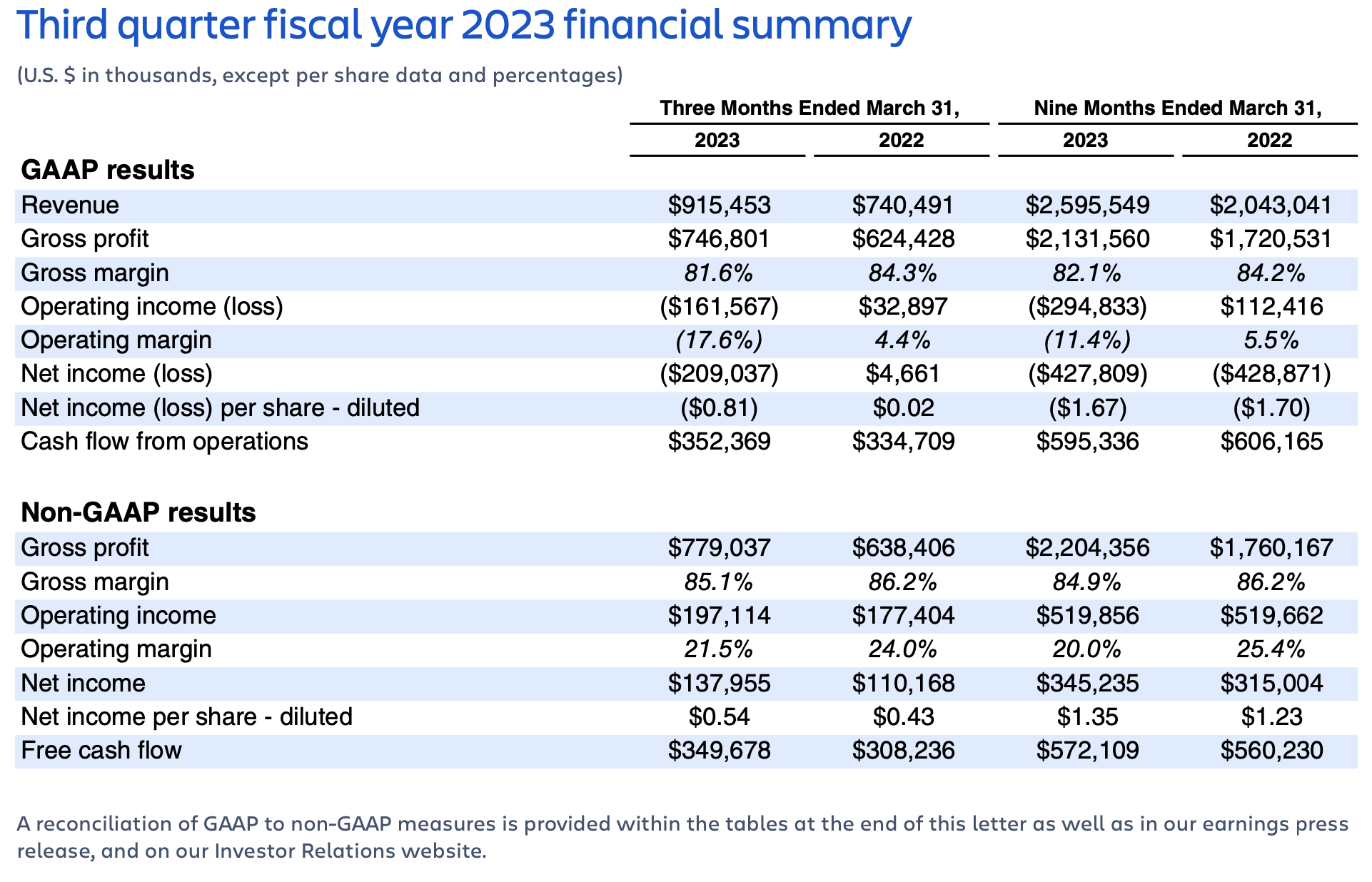
In Q3’23, we incurred charges associated with rebalancing our resources to accelerate progress against our highest priorities and consolidating leases to optimize our real estate footprint consistent with our Team Anywhere strategy. These restructuring charges are excluded from our non-GAAP results and are as follows:

Third quarter fiscal year 2023 highlights
We delivered another quarter of solid financial results amidst a challenging macroeconomic environment in Q3, while making difficult but necessary decisions to enable faster execution against our largest growth opportunities and better serve our customers. Revenue, gross profit, and operating income exceeded our expectations demonstrating our ability to navigate the near term while remaining focused on the long term.
Trends in the quarter were largely consistent with the first half of our fiscal year. Cloud revenue growth was driven by existing customers and migration activity, while impacted by macro headwinds. Data Center revenue benefitted from strong renewals. And lastly, we continued to deliver on our plan to align costs with revenue growth by driving efficiencies and slowing the pace of hiring, while investing in our strategic priorities to provide compelling value to customers and drive long-term growth.
We continue to have conviction in the long-term opportunities we see ahead of us and are focused on executing to achieve them.
Highlights for Q3’23 include:
All growth comparisons below relate to the corresponding period of last year, unless otherwise noted.
- Revenue of $915 million increased 24%, driven by growth in our cloud and Data Center offerings.
- GAAP gross margin of 82% decreased 3 percentage points. Non-GAAP gross margin of 85% decreased 1 percentage point driven by revenue mix shift to the cloud.
- GAAP operating loss was $162 million and GAAP operating margin of (18%) decreased 22 percentage points. Non-GAAP operating income was $197 million and non-GAAP operating margin of 22% decreased 2 percentage points driven by the gross margin decline discussed above and growth in R&D and sales investments across our target markets and strategic priorities.
- Operating cash flow was $352 million. Free cash flow of $350 million increased 13%.
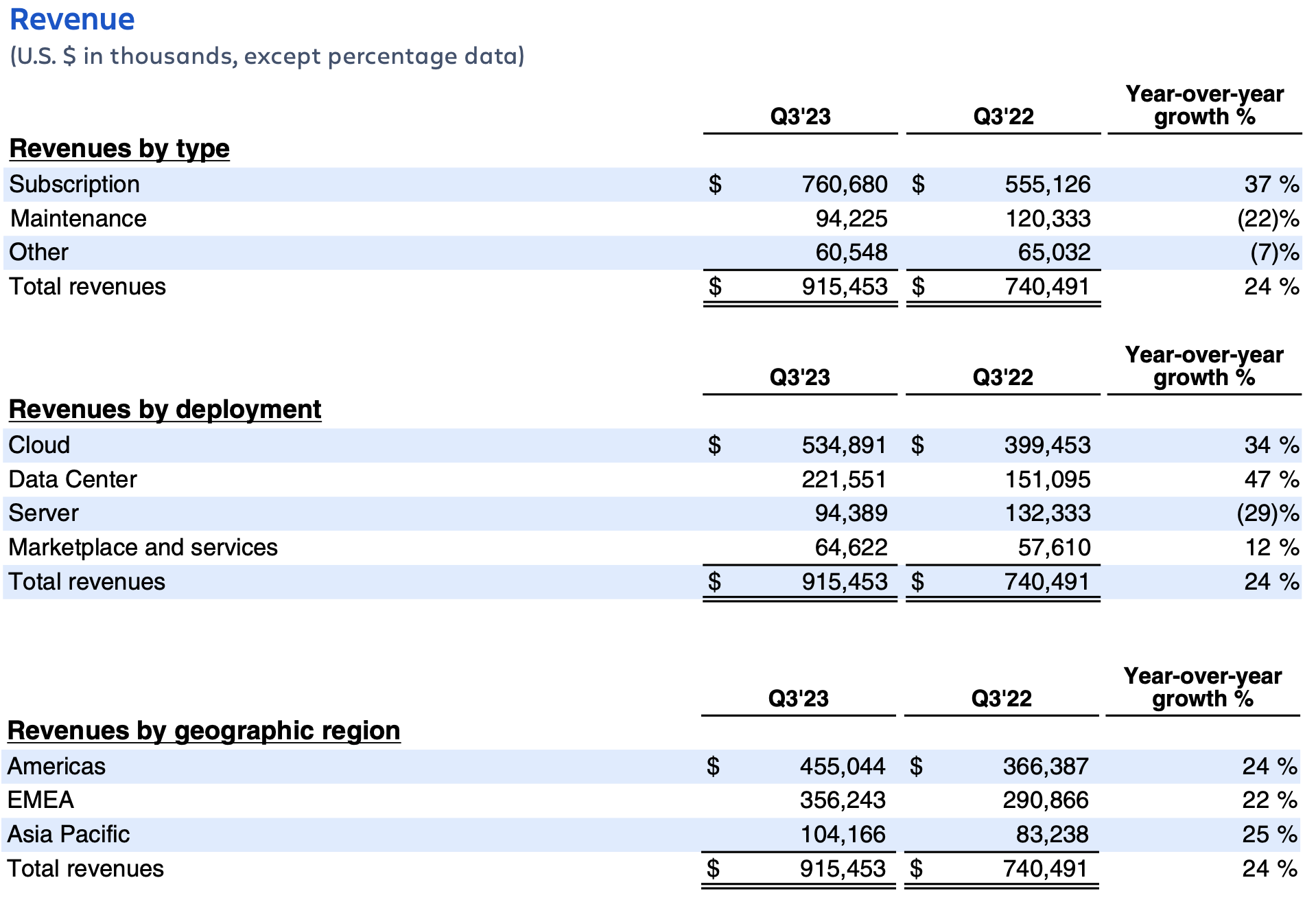
Revenue growth in the quarter was driven by subscription revenue, which grew 37%. Customers continue to turn to Atlassian in this challenging macroeconomic environment to help their teams work differently, together – allowing them to drive innovation and progress against their biggest challenges.
Cloud revenue growth of 34% was in line with our expectations driven by expansion from existing customers and migrations, as well as higher average revenue per user (ARPU) from increasing sales of our Premium and Enterprise editions and pricing tailwinds. The moderating growth rate of cloud revenue continues to be impacted by worsening macroeconomic headwinds on paid seat expansion from existing customers, free-to-paid conversions, and modest seat count reductions in some customers that have announced layoffs. Despite the challenging macroeconomic environment, we’re not seeing changes in our competitive position or in the inherent demand for our products. Monthly active users and customer retention remains healthy given the high-value, mission-critical nature of our cloud products and services.
Data Center revenue growth of 47% was driven by strong renewals and seat expansion from existing customers.
Lastly, deferred revenue increased 28% year-over-year to $1.4 billion driven by growth in annual cloud subscriptions and multi-year customer commitments to the Atlassian platform.

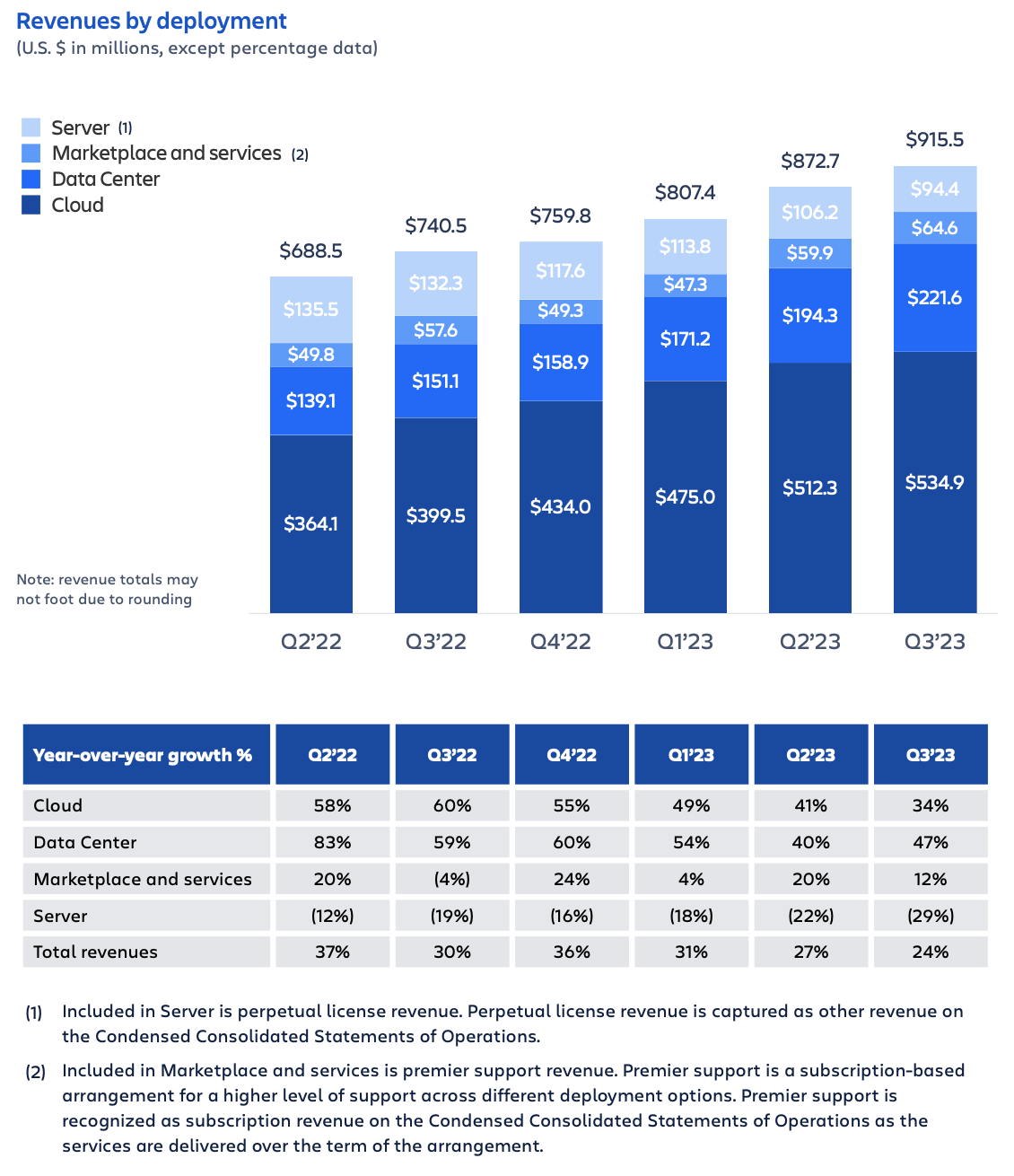

GAAP operating expenses increased 54% year-over-year driven by restructuring charges of $89 million, which contributed to 15 percentage points of the year-over-year increase. Non-GAAP operating expenses increased 26% year-over-year, and were lower than expected due to payroll savings from lower bonus expense and headcount, as well as greater than expected savings in discretionary spending areas such as professional services and travel and entertainment as part of our commitment to drive operational efficiency.
Headcount
Total employee headcount was 11,067 at the end of Q3’23, which includes approximately 500 employees that were impacted by the company’s rebalancing of resources and will not be included in our headcount by the end of Q4’23. We added 280 net new Atlassians in Q3, as we moderated headcount growth consistent with our plans to slow the pace of hiring in the second half of FY23.

Q3’23 GAAP net loss includes the restructuring charges of $98 million, and an income tax charge of $42 million for an adjustment to our uncertain tax provisions related primarily to transfer pricing. These charges increased GAAP net loss per diluted share by $0.54, net of tax effects.

Free cash flow in Q3’23 includes $5 million of payments for employee severance and other termination benefits related to the restructuring actions discussed above. We expect to make the remaining $21 million of payments for severance and other termination benefits in Q4’23.
Financial targets

Q4’23 Outlook
Total revenue
For Q4’23, we expect total company revenue to be in the range of $900 million to $920 million. This guidance implies full-year FY23 total revenue growth of approximately 25% year-over-year, consistent with our prior FY23 guidance. This guidance assumes the macroeconomic trends we have seen to date continue to worsen in Q4. Further detail is provided below:
SUBSCRIPTION REVENUE
Cloud revenue
We expect Q4’23 Cloud revenue growth of approximately 26% to 28% year-over-year, with increasing macroeconomic impacts on paid seat expansion from existing customers and new customer conversions, as well as headwinds in areas we have yet to see significant impact such as churn or upsell to Premium and Enterprise editions of our products. We continue to expect migrations to perform in line with our plan, and assume approximately 10 points of Cloud revenue growth to be driven by migrations.
This guidance implies full-year FY23 Cloud revenue growth of approximately 37% year-over-year, within the range of our prior FY23 guidance of 35% to 40%.
Data Center revenue
We expect strong renewals and seat expansion to continue to drive healthy Data Center revenue growth in Q4’23, albeit at a more moderate rate than Q3’23.
MAINTENANCE REVENUE
In line with our announced Server end-of-life, we expect maintenance revenue to continue to decline to approximately $85 million in Q4’23. As a reminder, we will no longer provide maintenance and support for our Server offerings beginning February 2024.
OTHER REVENUE
We expect Q4’23 Other revenue, which is primarily comprised of Marketplace revenue, to be sequentially flat compared to Q3’23. As a reminder, revenue on the sale of third-party Marketplace apps is recognized in the period the product is purchased, which adds quarter-to-quarter volatility in Marketplace growth rates.
Operating margin
We expect Q4’23 GAAP operating margin will be approximately (11%) and non-GAAP operating margin will be approximately 17%. Our Q4’23 operating margin will benefit from approximately $20 million, or 2 percentage points, of employee and lease related expense savings from our Q3 restructuring actions discussed above. We plan to reinvest these savings in FY24 in strategic priorities that deliver differentiated innovation and customer value with durable, long-term growth. We are well positioned to deepen our competitive advantages in each of our three large and growing markets, and emerge from this macroeconomic environment as a stronger company.
Sharecount
We expect less than 2% year-over-year increase in diluted share count in Q4’23.
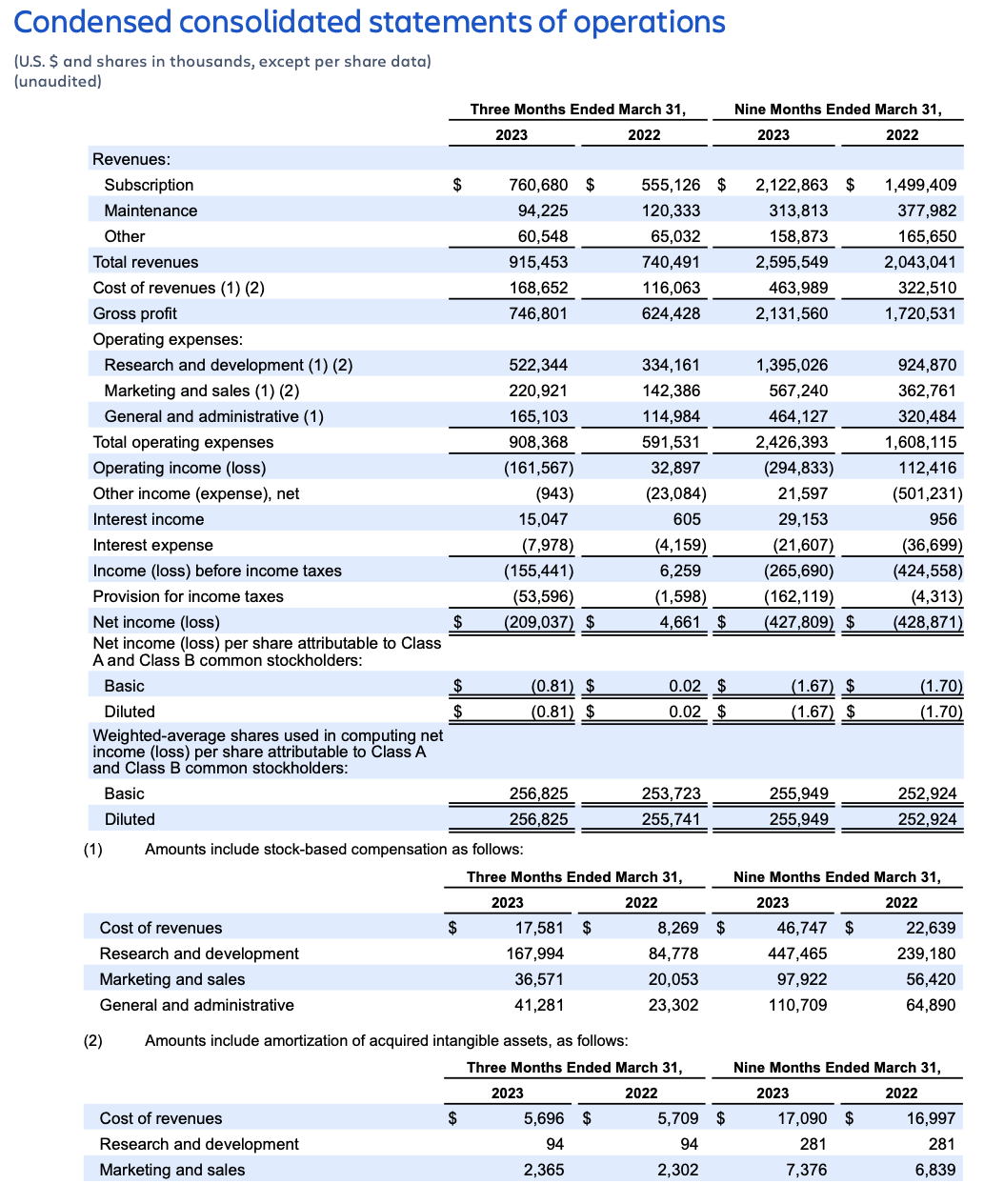
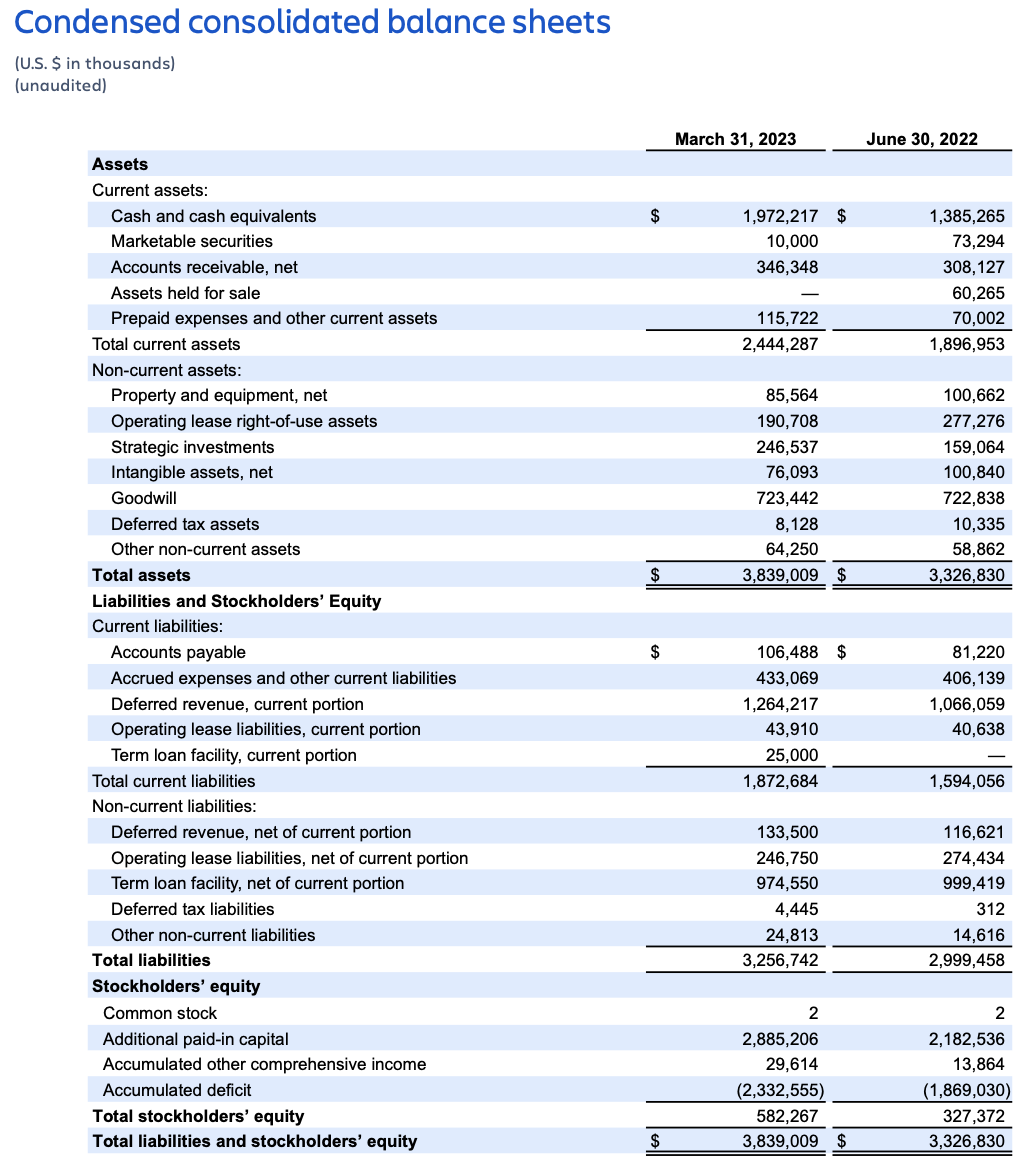

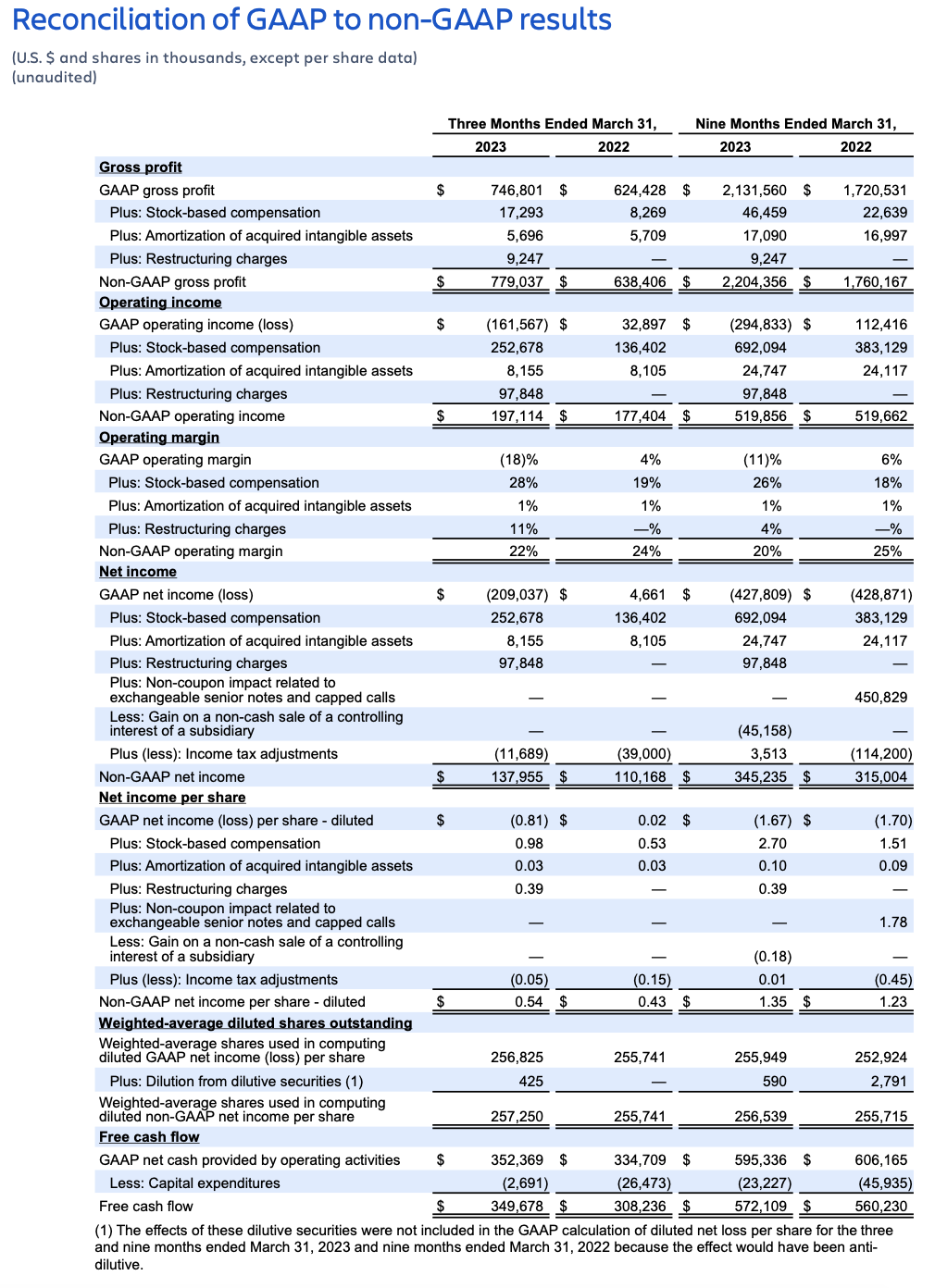

Forward-looking statements
This shareholder letter contains forward-looking statements within the meaning of Section 27A of the Securities Act of 1933, as amended, Section 21E of the Securities Exchange Act of 1934, as amended, and the Private Securities Litigation Reform Act of 1995, which statements involve substantial risks and uncertainties. In some cases, you can identify these statements by forward-looking words such as “may,” “will,” “expect,” “believe,” “anticipate,” “intend,” “could,” “should,” “estimate,” or “continue,” and similar expressions or variations, but these words are not the exclusive means for identifying such statements. All statements other than statements of historical fact could be deemed forward looking, including risks and uncertainties related to statements about our products, product features, including the introduction of AI and large language models, customers, Atlassian Marketplace, cloud migrations, macroeconomic environment, anticipated growth, the effects of our recent restructuring, outlook, technology, and other key strategic areas, and our financial targets such as revenue and GAAP and non-GAAP financial measures including gross margin and operating margin.
We undertake no obligation to update any forward-looking statements made in this shareholder letter to reflect events or circumstances after the date of this shareholder letter or to reflect new information or the occurrence of unanticipated events, except as required by law.
The achievement or success of the matters covered by such forward-looking statements involves known and unknown risks, uncertainties and assumptions. If any such risks or uncertainties materialize or if any of the assumptions prove incorrect, our results could differ materially from the results expressed or implied by the forward-looking statements we make. You should not rely upon forward-looking statements as predictions of future events. Forward-looking statements represent our management’s beliefs and assumptions only as of the date such statements are made.
Further information on these and other factors that could affect our financial results is included in filings we make with the Securities and Exchange Commission (the “SEC”) from time to time, including the section titled “Risk Factors” in our most recently filed Forms 20-F and 10-Q. These documents are available on the SEC Filings section of the Investor Relations section of our website at: https://investors.atlassian.com.
About non-GAAP financial measures
In addition to the measures presented in our condensed consolidated financial statements, we regularly review other measures that are not presented in accordance with GAAP, defined as non-GAAP financial measures by the SEC, to evaluate our business, measure our performance, identify trends, prepare financial forecasts and make strategic decisions. The key measures we consider are non-GAAP gross profit, non-GAAP operating income and non-GAAP operating margin, non-GAAP net income, non-GAAP net income per diluted share and free cash flow (collectively, the “Non-GAAP Financial Measures”). These Non-GAAP Financial Measures, which may be different from similarly titled non-GAAP measures used by other companies, provide supplemental information regarding our operating performance on a non-GAAP basis that excludes certain gains, losses and charges of a non-cash nature or that occur relatively infrequently and/or that management considers to be unrelated to our core operations. Management believes that tracking and presenting these Non-GAAP Financial Measures provides management, our board of directors, investors and the analyst community with the ability to better evaluate matters such as: our ongoing core operations, including comparisons between periods and against other companies in our industry; our ability to generate cash to service our debt and fund our operations; and the underlying business trends that are affecting our performance.
Our Non-GAAP Financial Measures include:
- Non-GAAP gross profit. Excludes expenses related to stock-based compensation, amortization of acquired intangible assets, and restructuring charges.
- Non-GAAP operating income and non-GAAP operating margin. Excludes expenses related to stock-based compensation, amortization of acquired intangible assets, and restructuring charges.
- Non-GAAP net income and non-GAAP net income per diluted share. Excludes expenses related to stock-based compensation, amortization of acquired intangible assets, restructuring charges, non-coupon impact related to exchangeable senior notes and capped calls, gain on a non-cash sale of a controlling interest of a subsidiary and the related income tax effects on these items, and a non-recurring income tax adjustment.
- Free cash flow. Free cash flow is defined as net cash provided by operating activities less capital expenditures, which consists of purchases of property and equipment.
We understand that although these Non-GAAP Financial Measures are frequently used by investors and the analyst community in their evaluation of our financial performance, these measures have limitations as analytical tools, and you should not consider them in isolation or as substitutes for analysis of our results as reported under GAAP. We compensate for such limitations by reconciling these Non-GAAP Financial Measures to the most comparable GAAP financial measures. We encourage you to review the tables in this shareholder letter titled “Reconciliation of GAAP to Non-GAAP Results” and “Reconciliation of GAAP to Non-GAAP Financial Targets” that present such reconciliations.
About Atlassian
Atlassian unleashes the potential of every team. Our agile & DevOps, IT service management and work management software helps teams organize, discuss, and complete shared work. The majority of the Fortune 500 and over 250,000 companies of all sizes worldwide – including NASA, Kiva, Deutsche Bank, and Salesforce – rely on our solutions to help their teams work better together and deliver quality results on time. Learn more about our products, including Jira Software, Confluence, Jira Service Management, Trello, Bitbucket, and Jira Align at atlassian.com.
Investor relations contact: Martin Lam, IR@atlassian.com
Media contact: M-C Maple, press@atlassian.com


